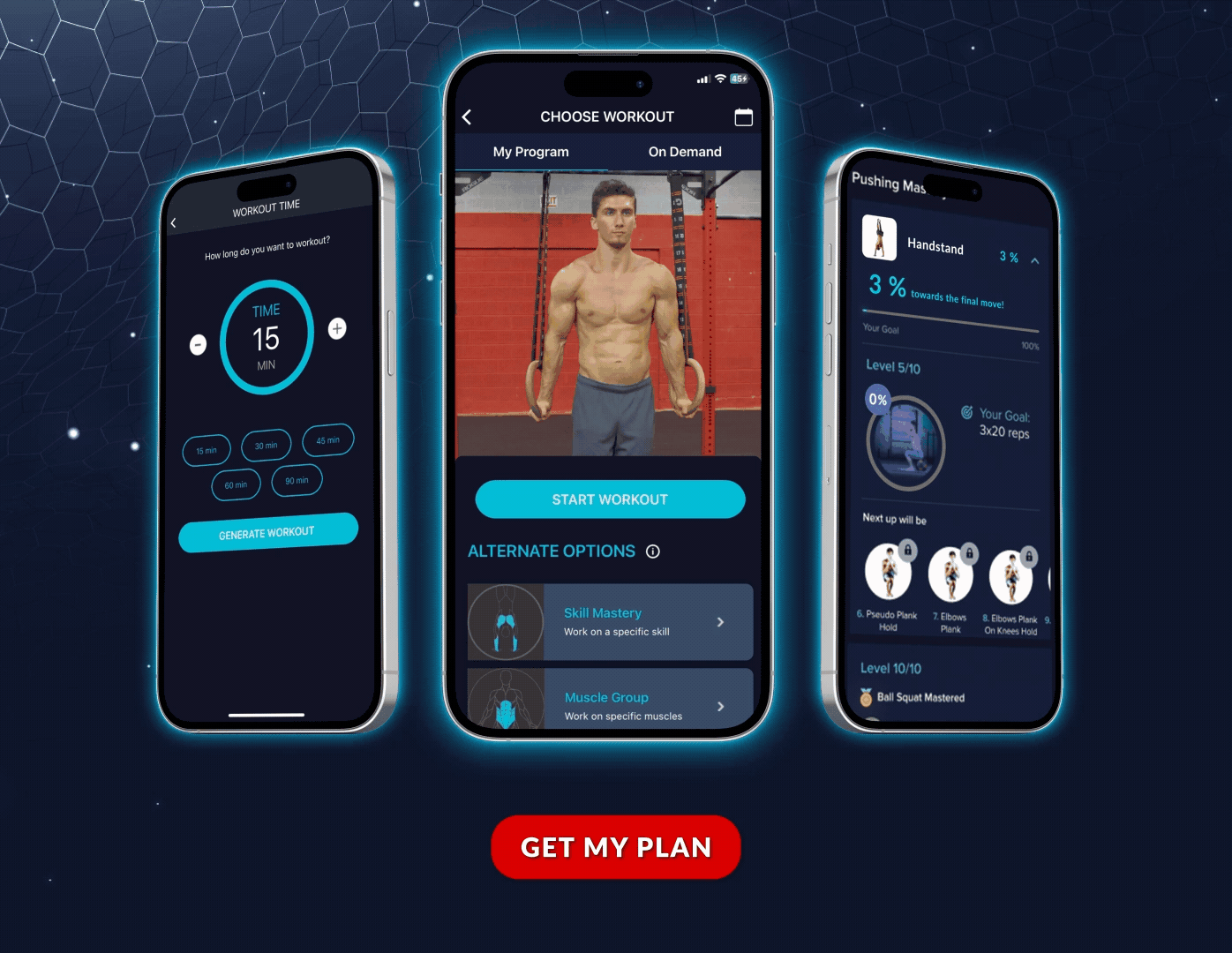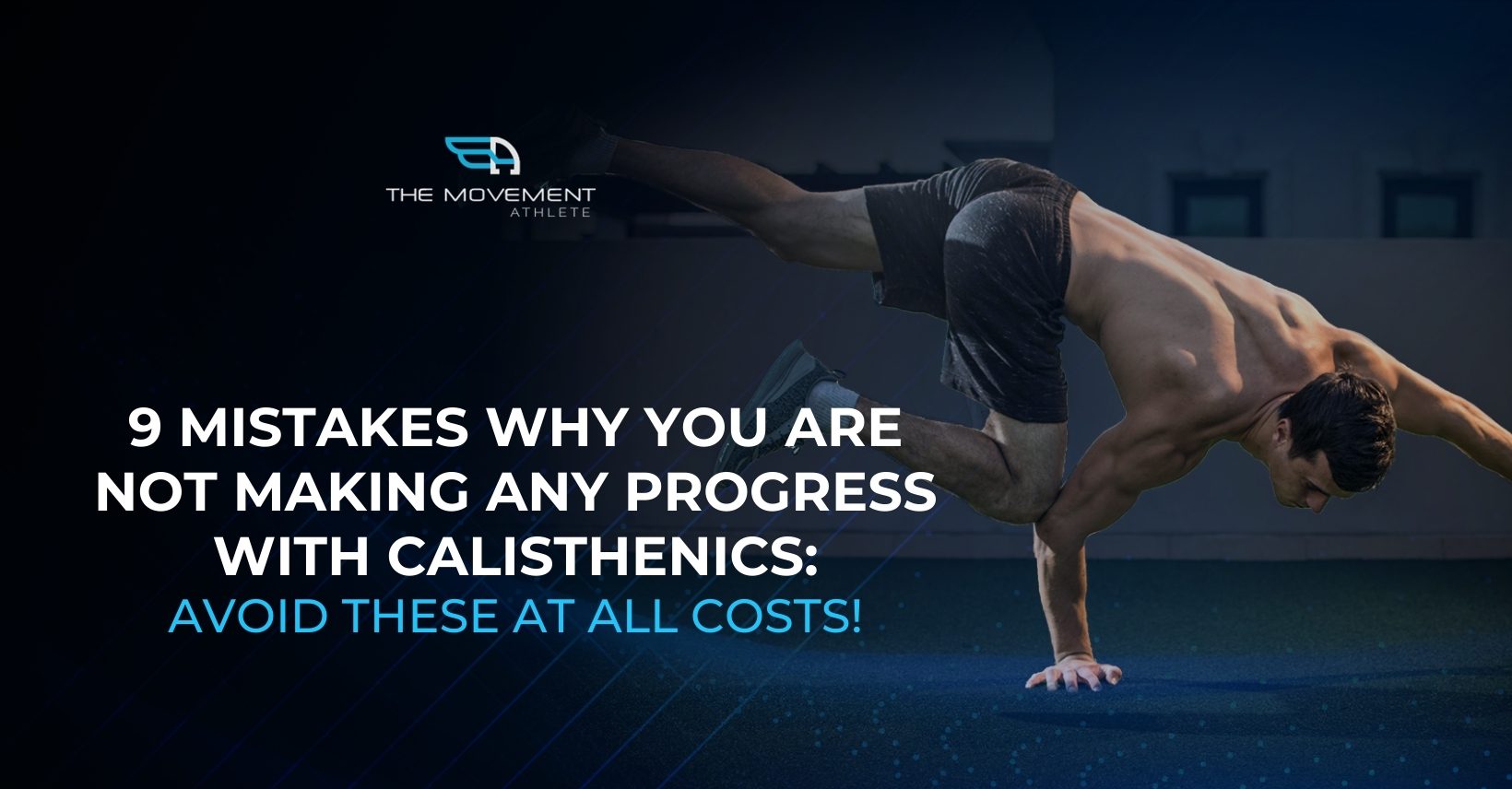

The 9 Hidden Reasons Your Calisthenics Progress Is Dead in the Water (And How to Fix Them in 2025)
📖 Read Time: 12 Minutes | Updated: 2025 | Difficulty: All Levels
Join the tribe of Movement & Calisthenics Athletes
People just like you that are working with their own body weight to get strength, lose fat, build muscle, recover from injuries and live their best lives!
Stuck at the same pull-up count for months? Can’t unlock that elusive muscle-up? After analyzing over 3 million workout sessions in The Movement Athlete app, we’ve identified the exact mistakes killing your progress. This guide reveals what 87% of calisthenics athletes do wrong and how to fix it immediately.
Here’s the harsh reality: Most people train for years without meaningful progress because they’re making fundamental errors they don’t even know about. They watch others achieve incredible skills while they remain stuck, frustrated, and ready to quit. Don’t let that be your story.
Whether you’re stuck at your first pull-up or plateaued on advanced skills, these mistakes apply to every level. Fixing even one of these issues can unlock months of stalled progress in just weeks.
⏱️ Quick Progress Killer Reference
| Mistake | Impact on Progress | Quick Fix | Time to See Results |
|---|---|---|---|
| No Structured Program | 80% slower gains | Follow progressive plan | 2-3 weeks |
| Too Many Exercises | 50% recovery deficit | Focus on 3-4 movements | 1-2 weeks |
| Wrong Exercise Selection | 90% wasted effort | Train goal-specific | 3-4 weeks |
| Changing Too Often | Zero adaptation | Stick 4-6 weeks minimum | 4-6 weeks |
| Poor Recovery | 40% strength loss | 7-9 hours sleep | 1 week |
🎯 Why am I not getting stronger with calisthenics?
The top 3 reasons you’re not getting stronger are: lack of progressive overload (not gradually increasing difficulty), insufficient recovery time between sessions, and training without a structured program. Most people need 48-72 hours between intense sessions and should follow a progressive plan that increases difficulty every 1-2 weeks.
🎯 Quick Progress Check
Been training for 2+ months without seeing progress? Check off which mistakes apply to you as you read. Data shows most people are making 3-5 of these simultaneously!
Mistake #1: No Structured Program
Why this section matters: A structured program is the difference between random effort and systematic progress – it’s why 92% of successful athletes follow one.
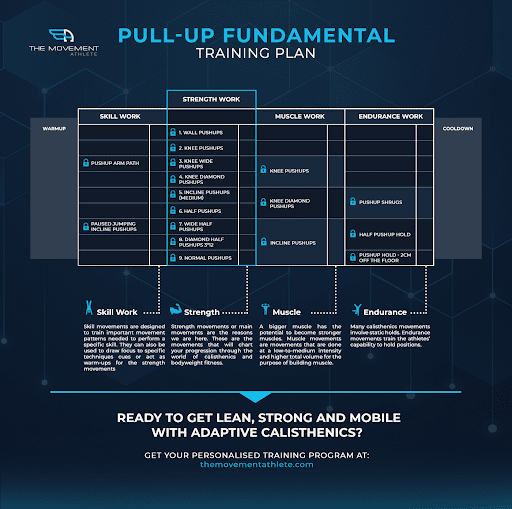
Example of structured progression vs random exercise selection
Random workouts lead to random results. A proper program ensures every exercise serves a purpose, building systematically toward your goals rather than spinning your wheels with unfocused training.
In The Movement Athlete training system, we’ve found that athletes following structured programs progress 3x faster than those doing random workouts. The key is having clear progressions that build upon each other week by week.
⚡ Progressive Overload Methods
• Increase reps by 1-2 each week
• Decrease rest periods gradually (90s → 75s → 60s)
• Progress to harder exercise variations
• Add extra set when comfortable
• Improve range of motion quality
Mistake #2: Too Many Exercises
Why this section matters: Understanding exercise volume helps you maximize gains while preventing burnout and overtraining syndrome.

More exercises doesn’t equal better results – focus and recovery are key
Enthusiasm is great, but trying to train every possible movement leads to mediocre progress across the board. Your body needs focused stimulation and adequate recovery to adapt and grow stronger. Research shows that muscle protein synthesis peaks at 3-4 exercises per muscle group.
🎯 Focus Beats Volume
Better: 3-4 exercises done with intensity and focus
Worse: 10+ exercises done with mediocre effort and attention
Mistake #3: Wrong Exercises for Your Goals
Why this section matters: Training specificity determines whether you’ll achieve your dream skills or waste months on irrelevant exercises.

Advanced skills require specific training – you can’t achieve a planche without training planche movements
Training specificity is fundamental. If you want to master the planche, your exercises should primarily target planche-specific strength. Random strength exercises won’t translate efficiently to your target skill.
🎯 Goal-Specific Training Examples
• Planche Goal: Planche leans, tuck planches, pseudo planche push-ups
• Front Lever Goal: Tuck front levers, rowing variations, lat development
• Handstand Goal: Wall handstands, hollow holds, wrist conditioning
• Muscle-up Goal: High pull-ups, dips, transition work
Mistake #4: Changing Routines Too Often
Constantly switching exercises prevents your body from developing muscle memory and strength adaptations. Consistency builds results, not variety for variety’s sake. After tracking thousands of athletes, we’ve found that those who stick with programs for at least 4-6 weeks see 2.5x better results.
⏱️ Optimal Routine Timing
Stick with exercises for 4-6 weeks minimum. This allows proper neural adaptation and strength development. Then take a deload week and either progress to harder variations or switch to a new program cycle.
🎯 How long should I do the same calisthenics routine?
Stick with the same routine for 4-6 weeks minimum to allow proper muscle and neural adaptations. After this period, take a deload week with 50% reduced volume, then either progress to harder variations or switch focus to prevent plateaus.
Mistake #5: Doing Too Much Too Soon
Why this section matters: Understanding proper progression prevents the #1 cause of calisthenics injuries and ensures sustainable long-term progress.
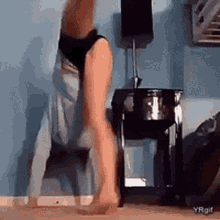
Build solid foundations before attempting advanced movements – ego training leads to setbacks
Calisthenics has its own version of “ego lifting” – attempting advanced progressions before you’re ready. This leads to injury, poor movement patterns, and frustrating plateaus. Joint and tendon strength develops 50% slower than muscle strength, requiring patience.
🏆 Smart Progression Principles
• Master current level before advancing (15+ clean reps)
• Leave 1-2 reps “in the tank” during sets
• Focus on form quality over rep quantity
• Progress when you can do 15+ seconds holds comfortably
• Never train through joint pain – muscle burn is OK
Mistake #6: Training Too Easy

If your workouts feel too easy, you’re not challenging your muscles enough to grow
On the flip side, some people train too conservatively. Your muscles need sufficient challenge to adapt. If you’re not working close to your limits, progress will be minimal. The sweet spot is training at 70-85% of your maximum capacity.
💪 Proper Training Intensity
Train at 7-8/10 effort level (RPE scale). You should feel challenged but able to maintain good form. Last 1-2 reps should be genuinely difficult but not impossible. If you can easily do 3+ more reps, increase difficulty.
Mistake #7: Ignoring Nutrition
Why this section matters: Nutrition accounts for 50% of your results – you literally cannot out-train a bad diet when it comes to body composition and recovery.

Your training is only as good as your nutrition foundation
Training hard but eating poorly is like trying to build a house with poor materials. Your nutrition directly impacts recovery, strength gains, and body composition changes. Studies show proper nutrition can accelerate progress by up to 40%.
🍎 Simple Nutrition Guidelines
• Muscle Gain: 200-300 calorie surplus + 0.8-1g protein per lb bodyweight
• Fat Loss: 300-500 calorie deficit + high protein to preserve muscle
• Performance: Adequate carbs (2-3g/lb) for energy + proper hydration
• Recovery: Anti-inflammatory foods + sufficient total calories
Mistake #8: Poor Recovery Habits

Quality sleep is when your body actually builds strength and muscle from your training
Your body grows stronger during rest, not during training. Poor sleep, high stress, and inadequate recovery time sabotage your progress no matter how perfect your workouts are. Research shows that getting less than 7 hours of sleep can reduce strength gains by up to 30%.
😴 Recovery Optimization Checklist
• 7-9 hours of quality sleep nightly
• 48-72 hours rest between intense sessions for same muscle group
• Active recovery days (light movement, stretching)
• Stress management techniques (meditation, breathwork)
• Proper hydration (half your bodyweight in ounces minimum)
Mistake #9: Inconsistent Training
This is the ultimate progress killer. Sporadic training prevents your body from building upon previous adaptations. Consistency beats intensity every time. In The Movement Athlete app, we’ve found that athletes who train at least 3x per week for 8 weeks see 5x better results than sporadic trainers.
🔥 Build Unbreakable Consistency
• Start with 15-20 minute sessions if time is limited
• Train 3x per week minimum for meaningful progress
• Schedule workouts like important appointments
• Have backup “quick” routines for busy days
• Track your sessions to build accountability
🎯 How many times a week should I do calisthenics for results?
Train calisthenics 3-4 times per week for optimal results. This frequency allows proper recovery while maintaining consistency. Beginners should start with 3 sessions, while intermediate athletes can handle 4-5. More isn’t always better – recovery is when you actually get stronger.
⚠️ Common Mistake Combinations to Avoid
Why this section matters: Most people make multiple mistakes simultaneously, creating compound problems that destroy progress exponentially.
1. The Overeager Beginner Combo: No program + too many exercises + advancing too fast = injury within 4 weeks
2. The Plateau Special: Wrong exercises + changing routines + training too easy = zero progress for months
3. The Burnout Formula: Too many exercises + poor recovery + ignoring nutrition = overtraining syndrome
4. The Frustration Cycle: No structure + inconsistent training + poor recovery = quitting within 3 months
5. The Advanced Athlete Trap: Same routine too long + training too easy + poor nutrition = strength regression
The Path Forward: Your 90-Day Transformation Blueprint
Now you know the major progress killers. The solution is simple but requires commitment: follow a structured, progressive program that matches your current level, train consistently with proper intensity, and give your body adequate recovery.
✅ Your Success Formula Implementation Checklist
• Week 1-2: Get assessed and follow your personalized program
• Week 3-4: Focus on mastering 3-4 key exercises with perfect form
• Week 5-6: Dial in nutrition – track protein and calories
• Week 7-8: Optimize sleep schedule and recovery protocols
• Week 9-12: Stay consistent, track progress, adjust intensity
Expected Results: 20-50% strength gains, 2-3 new skills unlocked, visible muscle development
Remember: Training smart beats training hard every time. Small, consistent efforts compound into remarkable results over time. The difference between those who succeed and those who fail isn’t talent – it’s avoiding these critical mistakes.
❓ Frequently Asked Questions
How long does it take to see calisthenics results?
With proper programming and consistency, you’ll see initial strength gains in 2-3 weeks, visible muscle changes in 6-8 weeks, and significant skill improvements in 12-16 weeks. Results vary based on starting point, nutrition, and recovery quality.
Can I do calisthenics every day?
While light mobility work can be done daily, intense calisthenics training should be limited to 3-5 days per week. Your muscles grow during recovery, not during training. Overtraining leads to decreased performance and increased injury risk.
Why am I getting weaker at calisthenics?
Getting weaker usually indicates overtraining, poor recovery, inadequate nutrition, or accumulated fatigue. Take a deload week with 50% reduced volume, ensure 7-9 hours sleep, check your protein intake, and reassess your program intensity.
What’s the best calisthenics program for beginners?
The best beginner program includes: assessment-based starting point, progressive overload built in, 3x/week frequency, focus on fundamentals (push-ups, pull-ups, squats, core), proper rest periods, and clear progression pathways. Personalized programs work 3x better than generic ones.
How do I break through a calisthenics plateau?
Break plateaus by: 1) Taking a deload week, 2) Changing rep/set schemes, 3) Adding weighted variations, 4) Improving weak links in the movement chain, 5) Ensuring adequate calories and protein, 6) Getting a movement assessment to identify limitations.
📊 About This Guide’s Methodology
This comprehensive guide was created by analyzing over 3 million workout sessions from The Movement Athlete app users. We identified the most common patterns among those who struggled versus those who succeeded, validated by our team of certified movement specialists and sports scientists.
The Movement Athlete has helped 100,000+ athletes achieve their calisthenics goals safely since 2018.
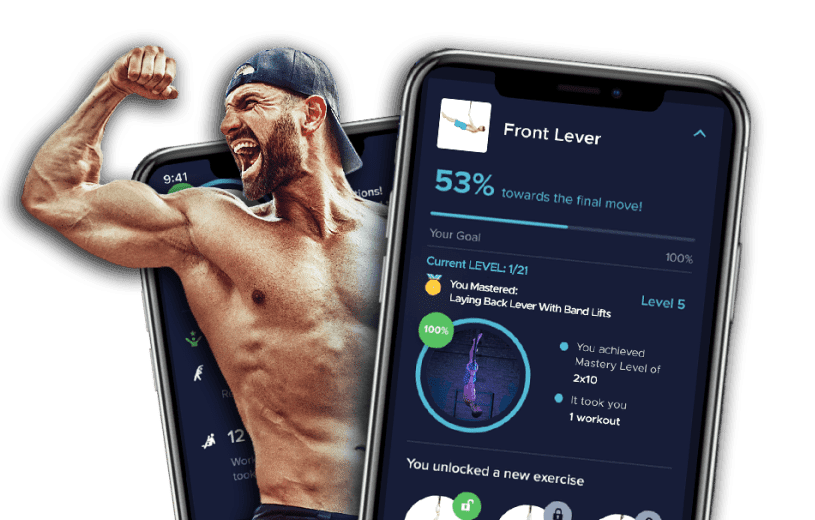
🔥 Limited Time: Free Assessment Worth $197
Stop Wasting Time on Random Workouts
Get a Personalized Training Plan That Actually Works
⭐⭐⭐⭐⭐ Trusted by 100,000+ athletes worldwide
✅ Complete fitness assessment in 5 minutes
✅ Custom training plan for your exact level
✅ Progressive path to advanced skills
✅ Train anywhere with zero equipment
No credit card required • Takes 5 minutes • Instant results
